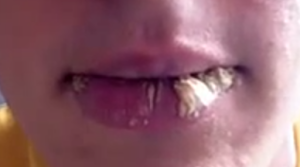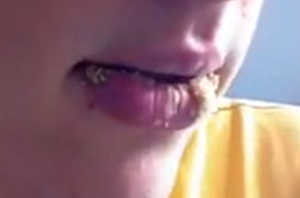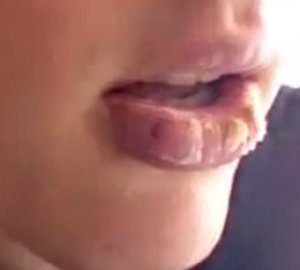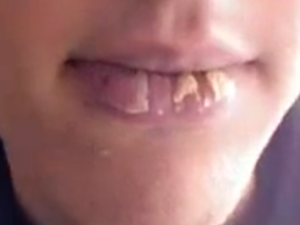Exfoliativecheilitis is a rare but chronic condition of the skin that is primarily observed in young adults and people younger than 30 years old. The vermilion border, i.e., the clear line that separated the reddish part of the lips and the nearby skin, bears the brunt of the effects of this condition. Exfoliative cheilitis being a chronic disorder tends occurs in episodes of flare ups and remission.The exact cause of the condition is not known, but self-damaging behavior, increased stress, poor oral hygiene, keratin accumulation, vitamin and nutritional deficiencies, weakened immune system, toxins buildup in body, and habits like licking, biting, sucking, or picking the lips and breathing via mouth can act as triggers.
Exfoliative cheilitis is a harmless condition, but it can also be a symptom of some serious underlying disease. Hence, patients need to visit a doctor for diagnosis and medical treatment if necessary.
Symptoms
Some of the common signs and symptoms of exfoliative cheilitis are listed below:
- Continuous peeling of the vermilion border or the outer section of the lips is the most common symptom of exfoliative cheilitis. Peeling can affect one or both the lips, but mainly tends to occur in the lower lip. In the initial stages, the lip skin appears normal, but later the topmost layer of skin on the vermilion border begins to harden and thicken.
- Peeling associated with exfoliative cheilitis is such that some section of the lips is always in the stage of peeling or flaking off, while other areas on the lips look normal. Continuous peeling eventually results in exposure of raw skin along with pain and burning sensations.
- The affected section of the lips may experience numbness and tingling sensations. Ulcers may also form on the lips. Additionally, patients may experience swelling, dryness, itching, and discoloration of the lips. Pain and other accompanying symptoms may be discomforting and result in overall distress.
- Raw skin is prone to bleeding and constant bleeding leads to formation of a hemorrhagic scab or crust. The development of ridges and cracks along with flaking may result in an ugly appearance and become the source of constant embarrassment.
- The unsightly appearance of the lips can sometimes cause psychological problems in patients such as stress, depression, anxiety, and mood swings, which may then cause them avoid socializing.
Causes of exfoliative cheilitis
Doctors are not aware about the exact cause of exfoliative cheilitis. However, the below listed factors may play a part in increasing the risk to developing the condition.
- Candida albicans is a fungus which naturally occurs in the body in minor quantities. Excessive growth of this in the mouth can cause an oral fungal infection which can then trigger a case of exfoliative cheilitis. The fungus typically remains inactive or dormant, and only gets activated or stimulated due to the presence of certain condition, thereby causing an infection.
- Lip peeling and associated symptoms can also occur due to hormone imbalances, reaction to implants in the mouth, and liver abnormalities.
- Certain activities of a person can also cause extensive damage to the lips and lead to occurrence of exfoliative cheilitis. These activities include breathing through the mouth, lip licking, lip biting, lip sucking, and lip picking, etc.
- Nutritional deficits can also trigger a case of exfoliative cheilitis. Secondary or primary deficits in vitamins and other nutrients can trigger deformation of keratin, which then cause the lips to peel, thicken, and inflame.
- HIV infected patients have a compromised immune system and hence are prone to developing a variety of skin conditions, including exfoliative cheilitis. The weakened immune system means that the body cannot defend itself against even minor infections of the skin, thereby triggering lip skin anomalies.
- Prolonged use of antibiotics can cause disturbances in the normal balance of bacteria and other microbes in the body, thereby facilitating the onset of exfoliative cheilitis.
- Poor oral hygiene, marked by improper brushing and oral cleaning practices increases the vulnerability of overgrowth of viruses, bacteria, and fungi in the mouth. This may eventually cause peeling and inflammation of the skin on the lips.
- People with underlying autoimmune diseases or an impaired immune system may also develop exfoliative cheilitis, when the immune system erroneously recognizes keratin in the skin for foreign matter and attacks it. Subsequent inflammation is what triggers skin peeling. Allergic reactions can cause similar effects on the lips’ skin.
Treatment of exfoliative cheilitis
Treatment of exfoliative cheilitis is dependent on the underlying causative condition.
- Nutritional deficiencies may be treated with diet changes and intake of vitamin supplements, etc.
- Medications like topical antifungals, antibiotics, and systemic steroid, etc. may be given to treat infections and associated symptoms.
- Lip inflammation and pain may be treated by using lip balms to keep them moist, cold compresses, and other home remedies.




